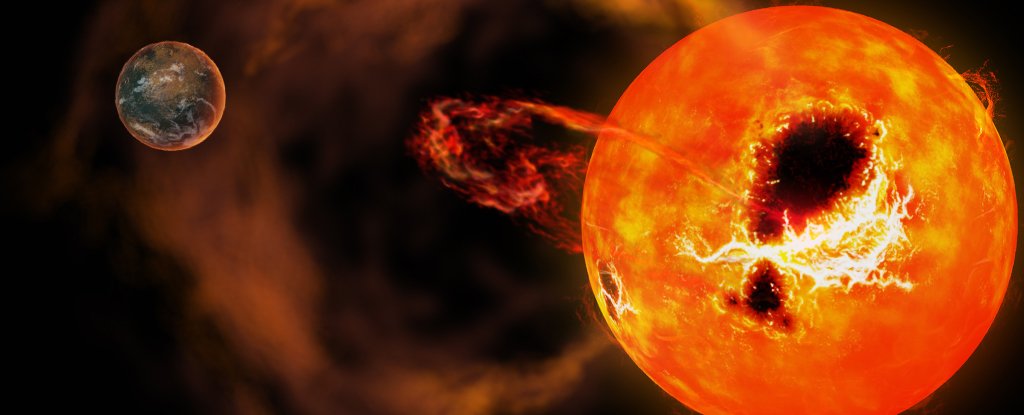Products You May Like
A red dwarf in our Sun’s own back yard seems to have a bad case of indigestion, belching out a flare roughly 20 times more impressive than anything known to come out of our own star.
The eruption was caught using a new telescope in Okayama, Japan, when astronomers trained its sights on the constellation Leo to study the kind of monster flares that could potentially wreak havoc should Earth ever stand in one’s way.
Over several nights in 2019, astronomers from Kyoto University and the National Astronomical Observatory of Japan collected data on a dozen flares produced by AD Leonis, a star 16 light-years away with a reputation for volatility.
Most of the plasma outbursts thrown off by the angry red dwarf were fairly run-of-the-mill affairs, but one was energetic enough to qualify as super-sized – a chance observation that surprised the researchers.
“Solar flares are sudden explosions that emanate from the surfaces of stars, including our own Sun,” says Kyoto University astronomer Kosuke Namekata.
“On rare occasions, an extremely large superflare will occur. These result in massive magnetic storms, which when emitted from our Sun can affect the Earth’s technological infrastructure.”
We have a pretty good idea of the mechanisms at work behind solar flares, at least where the smaller ones are concerned.
Magnetic fields produced by the churning of charged particles in a star store up energy in concentrated patches near the star’s surface, such as around sunspots.
As these fields break and reconfigure themselves, heated and fast flowing material is channelled from the corona deep into the atmosphere, triggering bursts of plasma and radiation that shoot through space at high speed.
Observed in the Sun, they can tell us a lot about the movements of gases in a star’s various layers and the complexities of solar activity.
As far as such eruptions go, our Solar System is relatively quiet. More magnetically active stars can really let rip, letting plasma fly with up to a million times more energy than our Sun usually musters.
Were Earth to weather the brunt of such an onslaught of fast, charged particles and high-energy radiation, it would be a roasting we wouldn’t forget.
It happens to be one reason we’re so keen to understand them – even mild geometric storms pose a serious hazard to global infrastructure, short-circuiting delicate satellites and interfering with Earth’s electronics below. So we don’t want to muck around when it comes to predicting them.
Fortunately, spotting a superflare event in a star just a few light-years away isn’t a major concern for us Earthlings.
In fact, having an opportunity to safely measure one from a close distance is a huge win for science.
“Our analyses of the superflare resulted in some very intriguing data,” says Namekata.
More precisely, comparing the superflare event with the less spectacular emissions revealed changes in energy that can help clarify the timing of various solar processes, and help us to distinguish the evolution of differently sized flares.
One of these new findings here included a jump in high-energy electrons that’s 10 times larger than anything seen in our Sun’s own flares. Strangely, this jump was measured exclusively in light produced by excited hydrogen atoms.
“This was new for us as well, because typical flare studies have observed the continuum of the light spectrum – the broad range of wavelengths – rather than energy coming from specific atoms,” says Namekata.
Exactly what this means will be left up to future investigations. But the fact it was seen in the team’s first week of observations using the shiny new 3.8-metre-wide Seimei optical-infrared telescope is either a good omen, or promising astronomy.
“This is the first time this phenomenon has been reported, and it’s thanks to the high precision of the Seimei Telescope,” says Namekata.
No doubt there are plenty more nearby eruptive stars out there, just waiting to squeeze out a colossal flare or two. And we’ll be waiting, watching from a safe distance when they do.
This research was published in the Publications of the Astronomical Society of Japan.
